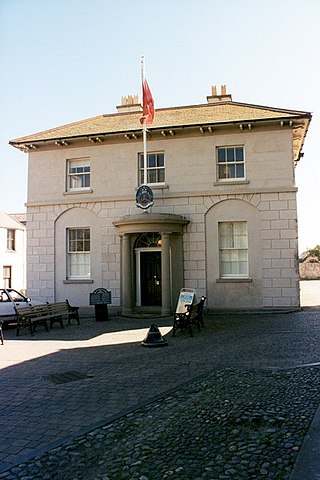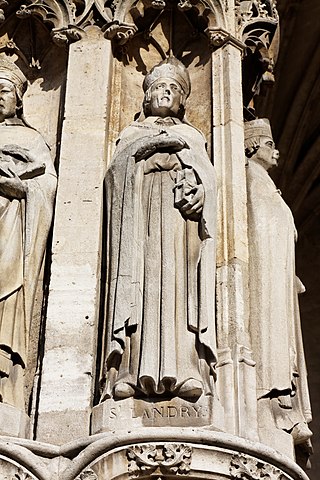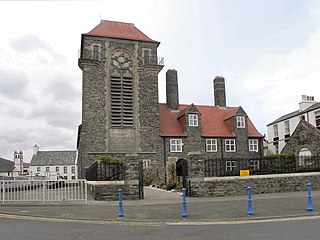
The Isle of Man had become physically separated from Great Britain and Ireland by 6500 BC. It appears that colonisation took place by sea sometime during the Mesolithic era. The island has been visited by various raiders and trading peoples over the years. After being settled by people from Ireland in the first millennium AD, the Isle of Man was converted to Christianity and then suffered raids by Vikings from Norway. After becoming subject to Norwegian suzerainty as part of the Kingdom of Mann and the Isles, the Isle of Man later became a possession of the Scottish and then the English crowns.

Germanus of Auxerre was a western Roman clergyman who was bishop of Autissiodorum in Late Antique Gaul. He abandoned a career as a high-ranking government official to devote his formidable energy towards the promotion of the church and the protection of his "flock" in dangerous times, personally confronting, for instance, the barbarian king "Goar". In Britain he is best remembered for his journey to combat Pelagianism in or around 429 AD, and the records of this visit provide valuable information on the state of post-Roman British society. He also played an important part in the establishment and promotion of the Cult of Saint Alban. The saint was said to have revealed the story of his martyrdom to Germanus in a dream or holy vision, and Germanus ordered this to be written down for public display. Germanus is venerated as a saint in both the Roman Catholic and Orthodox churches, which commemorate him on 31 July.

Saint Macarius of Alexandria was a monk in the Nitrian Desert. He was a slightly younger contemporary of Macarius of Egypt, and is thus also known as Macarius the Younger.

The culture of the Isle of Man is influenced by its Celtic and, to a lesser extent, its Norse origins, though its close proximity to the United Kingdom, popularity as a UK tourist destination, and recent mass immigration by British migrant workers has meant that British influence has been dominant since the Revestment period. Recent revival campaigns have attempted to preserve the surviving vestiges of Manx culture after a long period of Anglicisation, and significant interest in the Manx language, history and musical tradition has been the result.
Rigobert was a Benedictine monk and later abbot of the Abbaye Saint-Pierre d'Orbais who subsequently succeeded Saint Rieul as bishop of Reims in 698. He is venerated as a saint in the Catholic Church.

The Catholic Church in the Isle of Man is part of the worldwide Catholic Church, under the spiritual leadership of the Pope in Rome.

Amator(in French)Amadour or Amatre was bishop of Auxerre from 388 until his death on 1 May 418 and venerated as a saint in the Catholic Church. Amator's feast day is celebrated on 1 May.

Saint Erhard of Regensburg was bishop of Regensburg in the 7th century. He is identified with an Abbot Erhard of Ebersheimmunster mentioned in a Merovingian diploma of 684. Ancient documents call him also Erard and Herhard.

Ciarán of Saigir, also known as Ciarán mac Luaigne or Saint Kieran, was one of the Twelve Apostles of Ireland and is considered the first saint to have been born in Ireland, although the legend that he preceded Saint Patrick is questionable. Ciarán was bishop of Saighir (Seir-Kieran) and remains the patron saint of its successor, the diocese of Ossory.
Andrew the Scot was the Irish-born student and assistant of Donatus of Fiesole. He served as archdeacon of Fiesole under Bishop Donatus.
Erc mac Dega, also known (incorrectly) as Herygh, was an Irish saint. He was active in Cornwall. Tradition ascribes the foundation of the original monastery on the Hill of Slane to him.

Saint Patrick was a fifth-century Romano-British Christian missionary and bishop in Ireland. Known as the "Apostle of Ireland", he is the primary patron saint of Ireland, the other patron saints being Brigid of Kildare and Columba. Patrick was never formally canonised, having lived before the current laws of the Catholic Church in such matters. Nevertheless, he is venerated as a saint in the Catholic Church, the Lutheran Church, the Church of Ireland, and in the Eastern Orthodox Church, where he is regarded as equal-to-the-apostles and Enlightener of Ireland.
There is archaeological evidence of insular monasticism as early as the mid 5th century, influenced by establishments in Gaul such as the monastery of Martin of Tours at Marmoutier, the abbey established by Honoratus at Lérins; the abbey of Mont-Saint-Michel; and that of Germanus at Auxerre. Many Irish monks studied at Candida Casa near Whithorn in what is now Galloway in Scotland.

Saint Landry or Landericus of Paris was a bishop of Paris and is recognized as a saint by the Roman Catholic Church. Landry built a hospital dedicated to St. Christopher, which later became the Hôtel-Dieu de Paris. His feast day is 10 June.

Roolwer, also known as Hrólfr, was an eleventh-century ecclesiast. He is the first named bishop of a jurisdiction which later became the Diocese of the Isles, and appears to have served at his post before, and perhaps during, the reign of Gofraid Crobán, King of Dublin and the Isles. Roolwer's name appears to correspond to the Old Norse Hrólfr, which could mean that he is identical to either of two contemporary like-named bishops of Orkney. Roolwer's predecessor in the Isles may have been Dúnán, whose death in 1074 during the Dublin overlordship of Toirdelbach Ua Briain, King of Munster, may have enabled the ecclesiastical separation of Dublin from the Isles. The site of Roolwer's cathedral is unknown, although Maughold and St Patrick's Isle are possibilities.

The Our Lady, Star of the Sea & St Maughold Church is the name given to a religious building that is affiliated with the Catholic Church and is located in Dale Street, in Ramsey the second largest town in the Isle of Man, a dependency of the British Crown.
The Manannan Ballad or ManxTraditionary Ballad is a poem in Early Manx dating from about the beginning of the 16th century. It gives an account of the history of the Isle of Man and its rulers, ranging from the Gaelic god Manannán mac Lir up to Thomas Stanley, 1st Earl of Derby. The Manannan Ballad is the oldest datable work in the Manx language.

Saint Macculind was an early Irish saint who was abbot and / or bishop of Lusk.
Saint Joavan was an Irish priest and bishop in Brittany.
Saint Maccai was an Irish missionary who founded a monastery on the Isle of Bute, Scotland. His feast day is 11 April.















